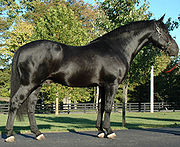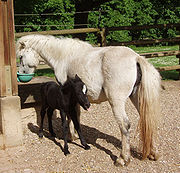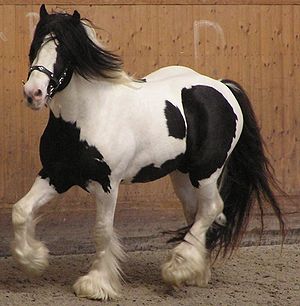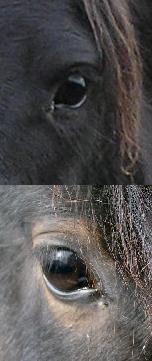
Black (horse)
Encyclopedia

Equine coat color
Horses exhibit a diverse array of coat colors and distinctive markings. A specialized vocabulary has evolved to describe them.While most horses remain the same color throughout life, a few, over the course of several years, will develop a different coat color from that with which they were born...
of horse
Horse
The horse is one of two extant subspecies of Equus ferus, or the wild horse. It is a single-hooved mammal belonging to the taxonomic family Equidae. The horse has evolved over the past 45 to 55 million years from a small multi-toed creature into the large, single-toed animal of today...
s in which the entire hair coat is black. Black is a relatively uncommon coat color, and novices frequently mistake dark chestnuts
Chestnut (coat)
Chestnut is a hair coat color of horses consisting of a reddish-to-brown coat with a mane and tail the same or lighter in color than the coat. Genetically and visually, chestnut is characterized by the absolute absence of true black hairs...
or bays for black. However, some breeds of horses, such as the Friesian horse
Friesian horse
The Friesian is a horse breed originating in Friesland, Netherlands. Although the breed's conformation resembles that of a light draft horse, Friesians are graceful and nimble for their size. During the Middle Ages, it is believed that the ancestors of Friesian horses were in great demand as war...
, Murgese
Murgese
The Murgese horse, also known as the Murghese or Murge Horse originated in the Murge, Apulia area of Italy during the Spanish rule, and were developed from Barb and Arabian horses...
and Ariegeois (or Merens) are almost exclusively black. Black is also common in the Fell pony
Fell pony
The Fell Pony is a versatile, working breed of mountain and moorland pony originating in the north of England in Cumberland and Westmorland and Northumberland. It was originally bred on the fell farms of northwest England, and is used as a riding and driving pony...
, Dales Pony
Dales Pony
-External links:****...
, Ostfriesen and Alt-Oldenburger, Kladruber
Kladruber
The Kladruber is the oldest Czech horse breed, and today is considered very rare. The main breeding centre is in National stud farm Kladruby nad Labem in the Czech republic where Kladrubers have been bred for more than 400 years, being now one of the world's oldest horse breeds...
, and Groningen
Groningen Horse
The Groningen Horse is a Dutch horse breed developed for light draft and agricultural work. It is closely related to heavy warmblood breeds like the East Friesian and Alt-Oldenburger...
.
True black horses have dark brown eyes, black skin, and wholly black hair coats without any areas of permanently reddish or brownish hair. They may have pink skin beneath any white markings
Horse markings
Markings on horses usually are distinctive white areas on an otherwise dark base coat color. Most horses have some markings, and they help to identify the horse as a unique individual. Markings are present at birth and do not change over the course of the horse's life...
under the areas of white hair, and if such white markings include one or both eyes, the eyes may be blue. Furthermore, most black horses "sun bleach" with exposure to the elements and sweat, and therefore their coats may lose some of their rich black character. Black horses that do not sun bleach are called "non-fading" or "sheer" blacks.
Visual identification

Horse markings
Markings on horses usually are distinctive white areas on an otherwise dark base coat color. Most horses have some markings, and they help to identify the horse as a unique individual. Markings are present at birth and do not change over the course of the horse's life...
. White markings and patterns such as pinto
Pinto horse
A pinto horse has a coat color that consists of large patches of white and any other color. The distinction between "pinto" and "solid" can be tenuous, as so-called "solid" horses frequently have areas of white hair. Various cultures throughout history appear to have selectively bred for pinto...
and leopard
Leopard (pattern)
Leopard is a term used to describe a spotted color pattern, particularly in the hair coat or skin of animals, but also used to describe spotting patterns in plants and fabrics...
have no bearing on the self-color of the animal.
Black foal
Foal
A foal is an equine, particularly a horse, that is one year old or younger. More specific terms are colt for a male foal and filly for a female foal, but these terms are used until the horse is age three or four. When the foal is nursing from its dam , it may also be called a suckling...
s are typically born a mousy gray but can be darker shades. As many foals have primitive markings
Primitive markings
Primitive markings among domestic horses are a group of hair coat markings and qualities associated with primitive breeds, and the dun coat color family in particular. All dun horses possess at least the dorsal stripe but the presence of the other primitive markings varies...
, some black foals are mistaken for grullo
Grullo
Grullo is a color of horses in the dun family, characterized by tan-gray or mouse-colored hairs on the body, often with shoulder and dorsal stripes and black barring on the lower legs. In this coloration each individual hair is mouse-colored, unlike a roan which is composed of a mixture of dark and...
or even bay dun; the primitive markings on a black foal will, however, fade. Black foals have dark skin and eyes at birth. An adult-like black foal coat often indicates that the foal will gray
Gray (horse)
Gray or grey is a coat color of horses characterized by progressive silvering of the colored hairs of the coat. Most gray horses have black skin and dark eyes; unlike many depigmentation genes, gray does not affect skin or eye color Their adult hair coat is white, dappled, or white intermingled...
, if the foal has at least one gray parent. Graying can be confirmed by the presence of white hairs around the eyes and muzzle. Gray Lipizzan
Lipizzan
The Lipizzan or Lipizzaner , is a breed of horse closely associated with the Spanish Riding School of Vienna, Austria, where the finest representatives demonstrate the haute école or "high school" movements of classical dressage, including the highly controlled, stylized jumps and other movements...
er horses are frequently born black.
Black adult horses are easier to identify, as the coat must be entirely black, even if superficially sun bleached. A sun bleached black may be confused with a dark bay, but a trained eye can distinguish between them, particularly by examining the fine hairs around the eyes and muzzle. When a black horse is sun-bleached, the mane and tail often sun bleach most prominently, and the rest of the coat may have a rusty tinge. A sun-bleached black may also be mistaken for the less common smoky black
Smoky black
Smoky black is a hair coat color of horses in which the coat is either black or a few shades lighter than true black. Smoky black is produced by the action of a heterozygous cream gene on an underlying black coat color...
, but can be distinguished by pedigree analysis or DNA testing.
Black mimics

- Dark bay or seal brownSeal brown (horse)Seal brown is a hair coat color of horses characterized by a near-black body color; with black points, the mane, tail and legs; but also reddish or tan areas around the eyes, muzzle, behind the elbow and in front of the stifle...
: The darkest shades of bay are commonly confused with black, even by experienced horse persons. However, a dark bay will always show some rich red character in its coat. Horses with a very dark coat that may appear black, but have tan or reddish hairs around the eyes, muzzle, armpits and stifle are sometimes called "seal brown", "mahogany bay", or "black bay." Both colors are genetically distinct from black and can be confirmed with a DNADNADeoxyribonucleic acid is a nucleic acid that contains the genetic instructions used in the development and functioning of all known living organisms . The DNA segments that carry this genetic information are called genes, but other DNA sequences have structural purposes, or are involved in...
test. - Liver chestnutChestnut (coat)Chestnut is a hair coat color of horses consisting of a reddish-to-brown coat with a mane and tail the same or lighter in color than the coat. Genetically and visually, chestnut is characterized by the absolute absence of true black hairs...
: Some red horses are so dark that they appear black, and are often called "black chestnuts" as a consequence. However, even the darkest liver chestnuts will show some red character in their coats, usually in the hair around the pastern or in the mane or tail. Even dark liver chestnuts do not have any true black pigment in their coats. This can be verified with DNA testing. Liver chestnut is very common in the Morgan horseMorgan horseThe Morgan is one of the earliest horse breeds developed in the United States. Tracing back to the stallion Figure, later named Justin Morgan after his best-known owner, the breed excels in many disciplines, and is known for its versatility....
. - Smoky blackSmoky blackSmoky black is a hair coat color of horses in which the coat is either black or a few shades lighter than true black. Smoky black is produced by the action of a heterozygous cream gene on an underlying black coat color...
: The action of the cream geneCream geneThe cream gene is responsible for a number of horse coat colors. Horses that have the cream gene in addition to a base coat color that is chestnut will become palomino if they are heterozygous, having one copy of the cream gene, or cremello, if they are homozygous. Similarly, horses with a bay...
in the heterozygous condition has a minimal effect on black pigment, so heterozygous creams with a black base coat (smoky blacks) differ little from true blacks. A smoky black will have at least one cream parent, is often born a pewter shade with blue eyes, and usually retains reddish hair inside the ear through adulthood.
Genetic identification

Equine coat color genetics
Equine coat color genetics determine a horse's coat color. There are many different coat colors possible, but all colors are produced by the action of only a few different genes. The simplest genetic default color of all domesticated horses can be described as either "red" or "non-red", depending...
, black is considered a "base" color, as is red
Chestnut (coat)
Chestnut is a hair coat color of horses consisting of a reddish-to-brown coat with a mane and tail the same or lighter in color than the coat. Genetically and visually, chestnut is characterized by the absolute absence of true black hairs...
. This designation makes the effects of other coat color gene
Gene
A gene is a molecular unit of heredity of a living organism. It is a name given to some stretches of DNA and RNA that code for a type of protein or for an RNA chain that has a function in the organism. Living beings depend on genes, as they specify all proteins and functional RNA chains...
s easier to understand. Coat colors that are designated "black-based" include grullo
Grullo
Grullo is a color of horses in the dun family, characterized by tan-gray or mouse-colored hairs on the body, often with shoulder and dorsal stripes and black barring on the lower legs. In this coloration each individual hair is mouse-colored, unlike a roan which is composed of a mixture of dark and...
(also called blue dun
Dun gene
The dun gene is a dilution gene that affects both red and black pigments in the coat color of a horse. The dun gene has the ability to affect the appearance of all black, bay, or chestnut -based horses to some degree by lightening the base body coat and suppressing the underlying base color to the...
), smoky black
Smoky black
Smoky black is a hair coat color of horses in which the coat is either black or a few shades lighter than true black. Smoky black is produced by the action of a heterozygous cream gene on an underlying black coat color...
, smoky cream, silver black
Silver dapple gene
The silver dapple gene is a dilution gene that affects the black base coat color. It will typically dilute a black mane and tail to flaxen, and a black body to a shade of brown or chocolate. It is responsible for a group of coat colors in horses called "silver dapple" in the west, or "taffy" in...
, classic champagne
Champagne gene
The champagne gene is a simple dominant allele responsible for a number of rare horse coat colors. The most distinctive traits of horses with the champagne gene are the hazel eyes and pinkish, freckled skin, which are bright blue and bright pink at birth, respectively...
, and blue roan
Roan (horse)
Roan is a horse coat color pattern characterized by an even mixture of colored and white hairs on the body, while the head and "points"—lower legs, mane and tail—are more solid-colored. The roan pattern is dominantly-inherited, and is found in many horse breeds...
. Sometimes this designation includes the bay family: bay, seal brown
Seal brown (horse)
Seal brown is a hair coat color of horses characterized by a near-black body color; with black points, the mane, tail and legs; but also reddish or tan areas around the eyes, muzzle, behind the elbow and in front of the stifle...
, buckskin, bay dun
Dun gene
The dun gene is a dilution gene that affects both red and black pigments in the coat color of a horse. The dun gene has the ability to affect the appearance of all black, bay, or chestnut -based horses to some degree by lightening the base body coat and suppressing the underlying base color to the...
, silver bay
Silver dapple gene
The silver dapple gene is a dilution gene that affects the black base coat color. It will typically dilute a black mane and tail to flaxen, and a black body to a shade of brown or chocolate. It is responsible for a group of coat colors in horses called "silver dapple" in the west, or "taffy" in...
, perlino, amber champagne
Champagne gene
The champagne gene is a simple dominant allele responsible for a number of rare horse coat colors. The most distinctive traits of horses with the champagne gene are the hazel eyes and pinkish, freckled skin, which are bright blue and bright pink at birth, respectively...
, and bay roan
Roan (horse)
Roan is a horse coat color pattern characterized by an even mixture of colored and white hairs on the body, while the head and "points"—lower legs, mane and tail—are more solid-colored. The roan pattern is dominantly-inherited, and is found in many horse breeds...
. Horses with a black-based coat may also have added spotting patterns including leopard
Leopard (pattern)
Leopard is a term used to describe a spotted color pattern, particularly in the hair coat or skin of animals, but also used to describe spotting patterns in plants and fabrics...
patterns seen on Appaloosa
Appaloosa
The Appaloosa is a horse breed best known for its colorful leopard-spotted coat pattern. There is a wide range of body types within the breed, stemming from the influence of multiple breeds of horses throughout its history. Each horse's color pattern is genetically the result of various spotting...
s and the pinto
Pinto horse
A pinto horse has a coat color that consists of large patches of white and any other color. The distinction between "pinto" and "solid" can be tenuous, as so-called "solid" horses frequently have areas of white hair. Various cultures throughout history appear to have selectively bred for pinto...
coloring known as piebald
Piebald
A piebald or pied animal is one that has a spotting pattern of large unpigmented, usually white, areas of hair, feathers, or scales and normally pigmented patches, generally black. The colour of the animal's skin underneath its coat is also pigmented under the dark patches and unpigmented under...
.
The genetics behind the black horse are relatively simple. The color black is primarily controlled by two genes: Extension
Melanocortin 1 receptor
The melanocortin 1 receptor , also known as melanocyte-stimulating hormone receptor , melanin-activating peptide receptor, or melanotropin receptor, is a G protein-coupled receptor which binds to a class of pituitary peptide hormones known as the melanocortins, of which include adrenocorticotropic...
and Agouti
Agouti signalling peptide
Agouti signalling peptide, a product of the Agouti gene, is a peptide consisting of 131 amino acids. Its discovery was published in 1994 in the scientific journal Nature where its functional properties were described...
. The functional, dominant
Dominance relationship
Dominance in genetics is a relationship between two variant forms of a single gene, in which one allele masks the effect of the other in influencing some trait. In the simplest case, if a gene exists in two allelic forms , three combinations of alleles are possible: AA, AB, and BB...
allele
Allele
An allele is one of two or more forms of a gene or a genetic locus . "Allel" is an abbreviation of allelomorph. Sometimes, different alleles can result in different observable phenotypic traits, such as different pigmentation...
of the extension gene (labeled "E") enables the horse to produce black pigment in the hair. Without this gene (homozygous recessive condition "ee"), the coat is devoid of black pigment and the horse is some shade of red
Chestnut (coat)
Chestnut is a hair coat color of horses consisting of a reddish-to-brown coat with a mane and tail the same or lighter in color than the coat. Genetically and visually, chestnut is characterized by the absolute absence of true black hairs...
. The functional, dominant allele (or alleles) of the agouti gene (labeled "A") enable the horse to restrict black pigment to certain parts of the coat, notably the legs, mane and tail, allowing the underlying red to show through, resulting in bay coloring. Without this gene (homozygous recessive condition "aa"), any black pigment present is unrestricted, resulting in a uniformly black coat.
Thus a black horse has at least one copy of the functional, dominant "E" allele and two copies of the non-functional, recessive "a" allele. A mature true black horse can be safely said to possess at least one dominant extension gene (EE or Ee); and has no other dominant genes (such as agouti, gray, or any of the dilution factors) that further modify color.
A DNA test, which uses hair with the root intact, has been developed to test for the Extension and Agouti genotype
Genotype
The genotype is the genetic makeup of a cell, an organism, or an individual usually with reference to a specific character under consideration...
s. However, the terminology can be manipulated. Unfortunately, the extension test is often mislabeled as the "black test", leading to confusion. Neither the extension test nor the agouti test alone can identify a black horse. Together, they can determine that a horse that appears visually black is not actually a dark bay or liver chestnut.
Horses described as "homozygous black" are simply homozygous for the dominant extension gene (EE); they are homozygous "not-red". Such horses are only "guaranteed" to never produce a red
Chestnut (coat)
Chestnut is a hair coat color of horses consisting of a reddish-to-brown coat with a mane and tail the same or lighter in color than the coat. Genetically and visually, chestnut is characterized by the absolute absence of true black hairs...
foal. The actual horse may carry additional genetic modifiers that could make it bay, buckskin, gray, bay roan, perlino, silver bay, and so on. A visually black horse that is tested "homozygous black" is EE and has no other color modifiers.
However, it has become popular for individuals owning a horse that is homozygous for the extension gene (EE) to claim that the horse will "throw black." But, generally speaking, one horse cannot be guaranteed to "throw black" with all mates. The mate of a true black horse may contribute the a dominant Agouti allele, which will suppress the black coloring and result in a bay foal. If a black is bred to a gray, the ensuing foal may also be gray. Other modifiers present in the mate may produce additional dilution colors or spotting patterns. Nonetheless certain individual pairings with appropriate DNA testing can, in some cases, be guaranteed to produce black.

